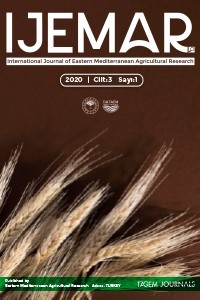Second Crop No-Till Safflower Crop Performance in South East Anatolia Reveals Speed Breeding Potential of Safflower
Safflower, Second crop, No-till, Drip irrigation
___
- Kızıl, S., & Sakar, D. (1997). Diyarbakır ekolojik koşullarında aspirde (Carthamus tinctorius L.) uygun ekim zamanının saptanması üzerine bir çalışma. Türkiye 2. Tarla Bitkileri Kongresi, 22-25 Eylül, s. 634-636, Samsun.
- Kızıl, S., & Gül, O. (1999). Diyarbakır koşullarında farklı ekim zamanlarının aspirde (Carthamus tinctorius L.) boyar madde oranı, taç yaprağı verimi ve bazı tarımsal karakterler üzerine etkisi. Türkiye 3. Tarla Bitkileri Kongresi, 15-18 Kasım, s. 241-246. Adana.
- Özkaynak, E., Samancı, B., & Başalma, D. (2001). Bazı aspir çeşitlerinde farklı ekim zamanlarının verim ve verimle ilgili özellikler üzerine etkisi. Türkiye 4. Tarla Bitkileri Kongresi, 17-21 Eylül, s. 79-83, Tekirdağ.
- Öztürk, Ö., Akınerdem, F., & Gönülal, E. (1999). Konya ekolojik şartlarında farklı ekim zamanı ve sıra aralıklarının aspirde (Carthamus tinctorius L.) tohum ve yağ verimine etkisi. Türkiye 3. Tarla Bitkileri Kongresi, 15-18 Kasım, s. 368-371, Adana.
- TUIK. (2013). Turkish Statistical Institute. Access date:12.08.2014
- ISSN: 2667-5102
- Yayın Aralığı: Yıllık
- Başlangıç: 2018
- Yayıncı: Eastern Mediterranean Agricultural Research Institute
Yerbademinin Tarımı ve Mekanizasyonunun Değerlendirilmesi
Mehmet Emin BİLGİLİ, Pınar ÇUBUKÇU, Yasemin VURARAK
Yerli Güney Sarısı Sığır Irkının Adana İli ve İlçelerindeki Mevcut Durumu
M. Çağrı UÇUK, A. Çağrı BIKMAZ, Uğur SEVİLMİŞ, Hatice HIZLI, Ayşe IŞIK
Ayçiçeği Yetiştiriciliğinde Enerji Kullanım Etkinliğinin Belirlenmesi: Adana İli Örneği
Hasan Ali KARAAĞAÇ, Ali BOLAT, Cengiz SAĞLAM, Ertan YAZGAN, Abdullah ÇİL
Uğur SEVİLMİŞ, Şerif KAHRAMAN, Halil KARAHAN
Sedat SÜLLÜ, Bekir Sıtkı ÖZBEK, Hacer KAYA KOCATÜRK, Ayten DOLANÇAY
Süt Sığırcılığı İşletmelerinde Süt Koku Problemleri, Değerlendirmesi ve Önleme Yolları
Portakal Kabuğu (Citrus sinensis L.) Uçucu Yağının Kanatlı Beslemedeki Önemi
Ahmet AYDIN, Medet KORKUNÇ, Dilek ŞENTÜRK DEMİREL, Sevilay GÜL
